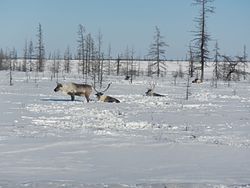Purovsky District
Пуровский район | |
|---|---|
 Tidd-Ottynskyy reserve: Purovsky District | |
| Anthem: Anthem of Purovsky District[2] | |
 Location of Purovsky District in Yamalo-Nenets Autonomous Okrug | |
| Coordinates: 64°54′53″N 77°46′22″E / 64.91472°N 77.77278°E | |
| Country | Russia |
| Federal subject | Yamalo-Nenets Autonomous Okrug[1] |
| Established | 1932 |
| Administrative center | Tarko-Sale[1] |
| Area | |
| • Total | 108,400 km2 (41,900 sq mi) |
| Population | |
| • Total | 51,280 |
| • Density | 0.47/km2 (1.2/sq mi) |
| • Urban | 59.4% |
| • Rural | 40.6% |
| Administrative structure | |
| • Inhabited localities[1] | 1 cities/towns, 1 Urban-type settlements[5], 8 rural localities |
| Municipal structure | |
| • Municipally incorporated as | Purovsky Municipal District[6] |
| • Municipal divisions[6] | 2 urban settlements, 6 rural settlements |
| Time zone | UTC+5 (MSK+2 |
| OKTMO ID | 71920000 |
| Website | http://www.puradm.ru/ |
Purovsky District (Russian: Пу́ровский райо́н) is an administrative[1] and municipal[6] district (raion), one of the seven in Yamalo-Nenets Autonomous Okrug of Tyumen Oblast, Russia. It is located in the center and south of the autonomous okrug. The area of the district is 108,400 square kilometers (41,900 sq mi).[3] Its administrative center is the town of Tarko-Sale.[1] Population: 51,280 (2010 Census);[4] 47,667 (2002 Census);[8] 56,049 (1989 Soviet census).[9] The population of Tarko-Sale accounts for 39.8% of the district's total population.[4]
- ^ a b c d e Law #42-ZAO
- ^ Decision #853
- ^ a b "General Information" (in Russian). Purovsky District. Retrieved August 31, 2016.
- ^ a b c Russian Federal State Statistics Service (2011). Всероссийская перепись населения 2010 года. Том 1 [2010 All-Russian Population Census, vol. 1]. Всероссийская перепись населения 2010 года [2010 All-Russia Population Census] (in Russian). Federal State Statistics Service.
- ^ The count of urban-type settlements may include the work settlements, the resort settlements, the suburban (dacha) settlements, as well as urban-type settlements proper.
- ^ a b c Law #113-ZAO
- ^ "Об исчислении времени". Официальный интернет-портал правовой информации (in Russian). June 3, 2011. Retrieved January 19, 2019.
- ^ Federal State Statistics Service (May 21, 2004). Численность населения России, субъектов Российской Федерации в составе федеральных округов, районов, городских поселений, сельских населённых пунктов – районных центров и сельских населённых пунктов с населением 3 тысячи и более человек [Population of Russia, Its Federal Districts, Federal Subjects, Districts, Urban Localities, Rural Localities—Administrative Centers, and Rural Localities with Population of Over 3,000] (XLS). Всероссийская перепись населения 2002 года [All-Russia Population Census of 2002] (in Russian).
- ^ Всесоюзная перепись населения 1989 г. Численность наличного населения союзных и автономных республик, автономных областей и округов, краёв, областей, районов, городских поселений и сёл-райцентров [All Union Population Census of 1989: Present Population of Union and Autonomous Republics, Autonomous Oblasts and Okrugs, Krais, Oblasts, Districts, Urban Settlements, and Villages Serving as District Administrative Centers]. Всесоюзная перепись населения 1989 года [All-Union Population Census of 1989] (in Russian). Институт демографии Национального исследовательского университета: Высшая школа экономики [Institute of Demography at the National Research University: Higher School of Economics]. 1989 – via Demoscope Weekly.

